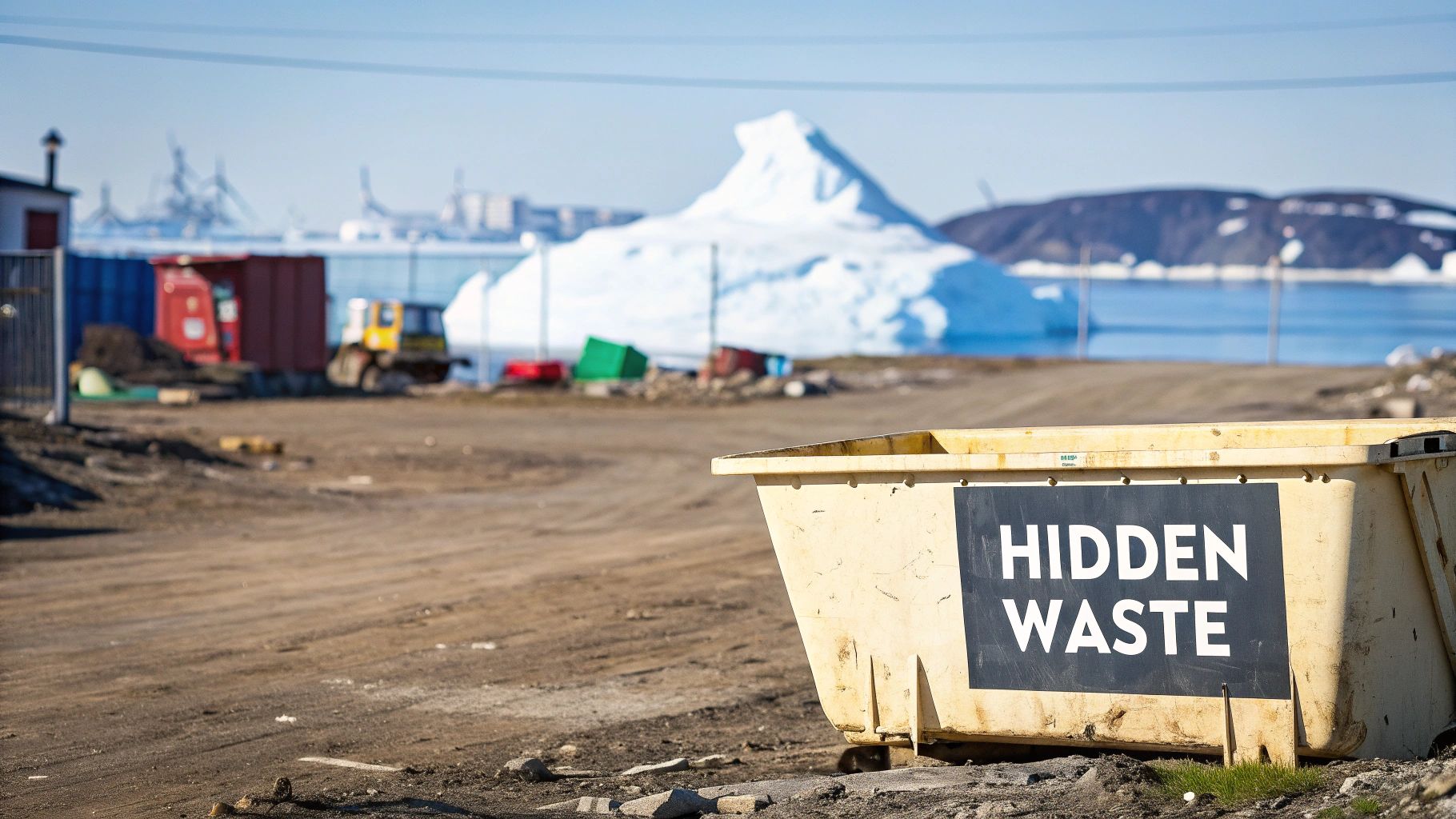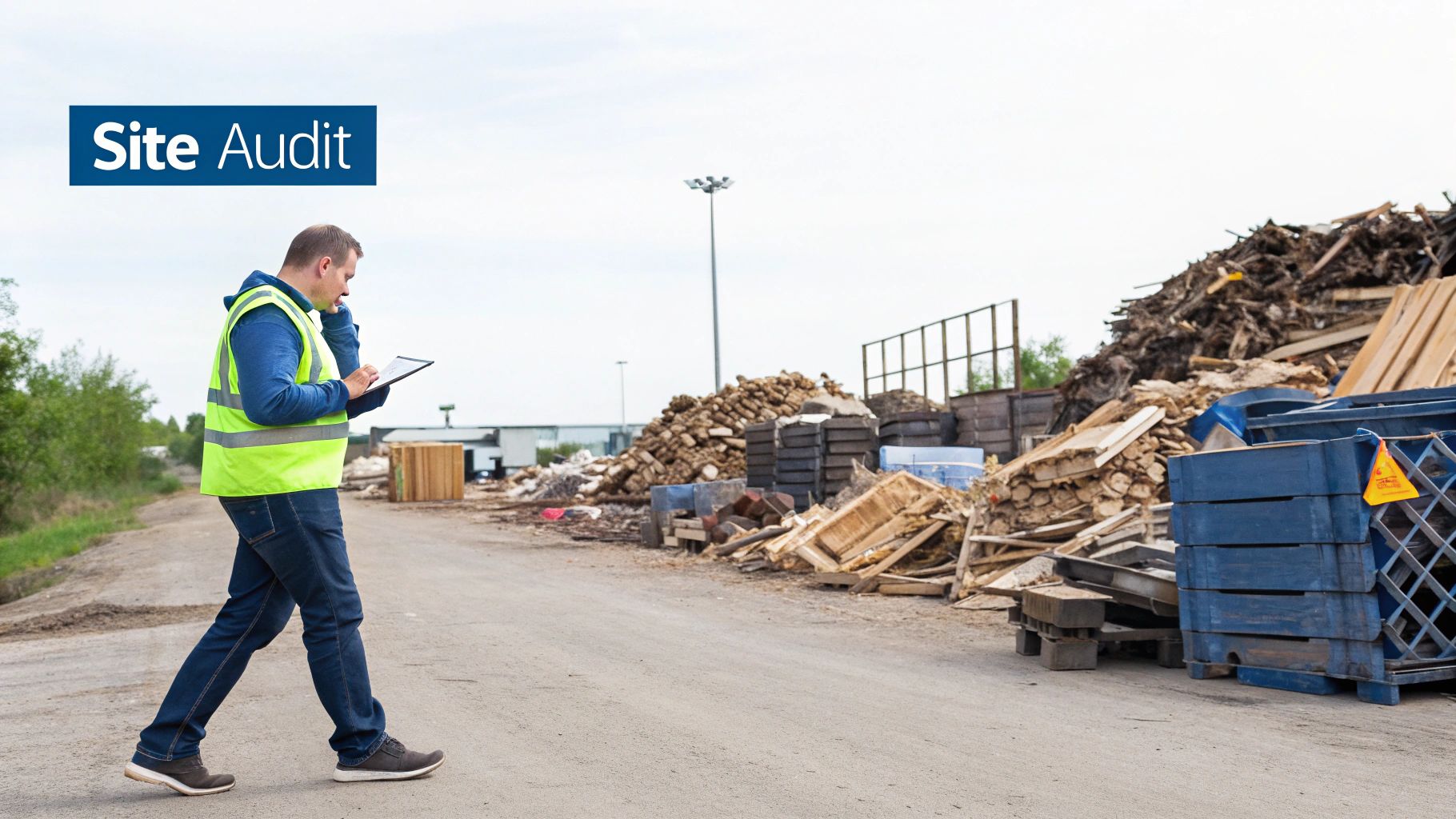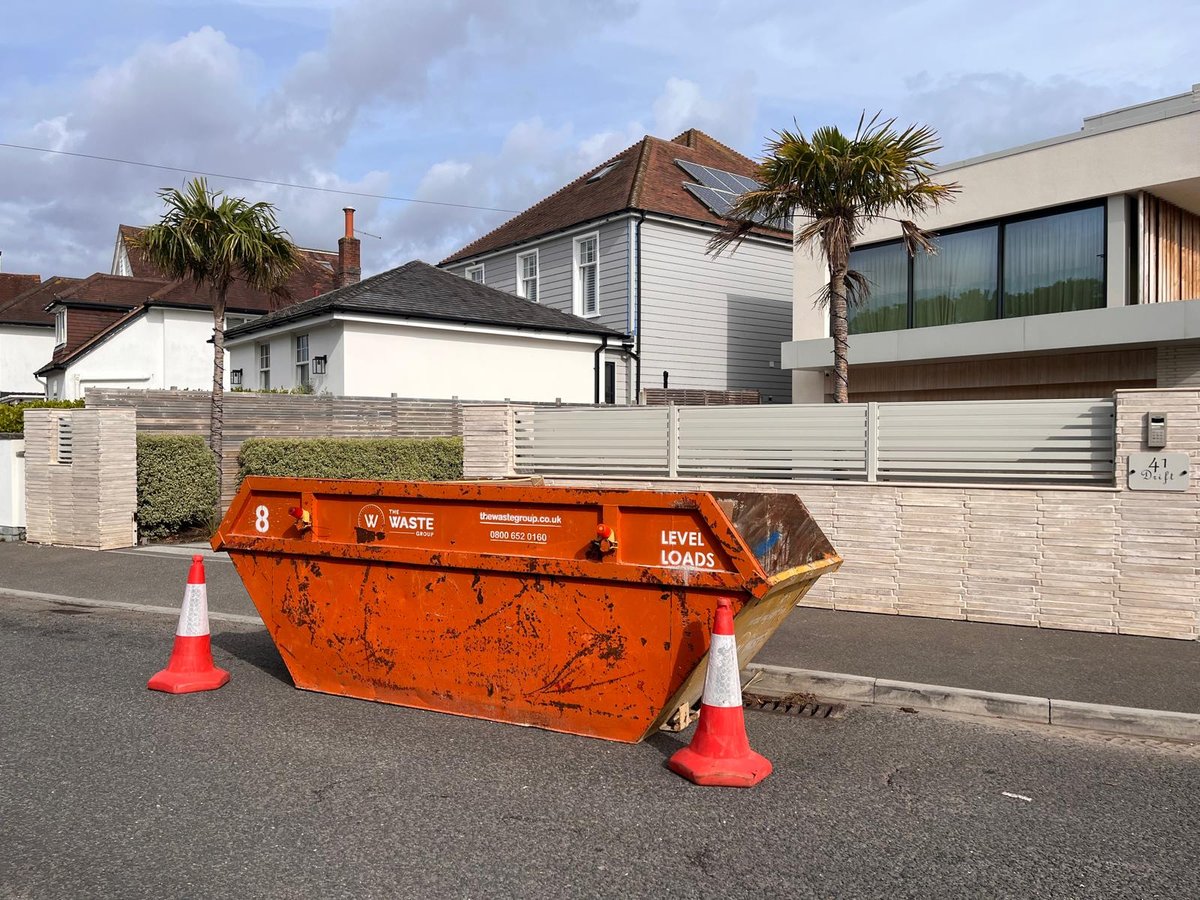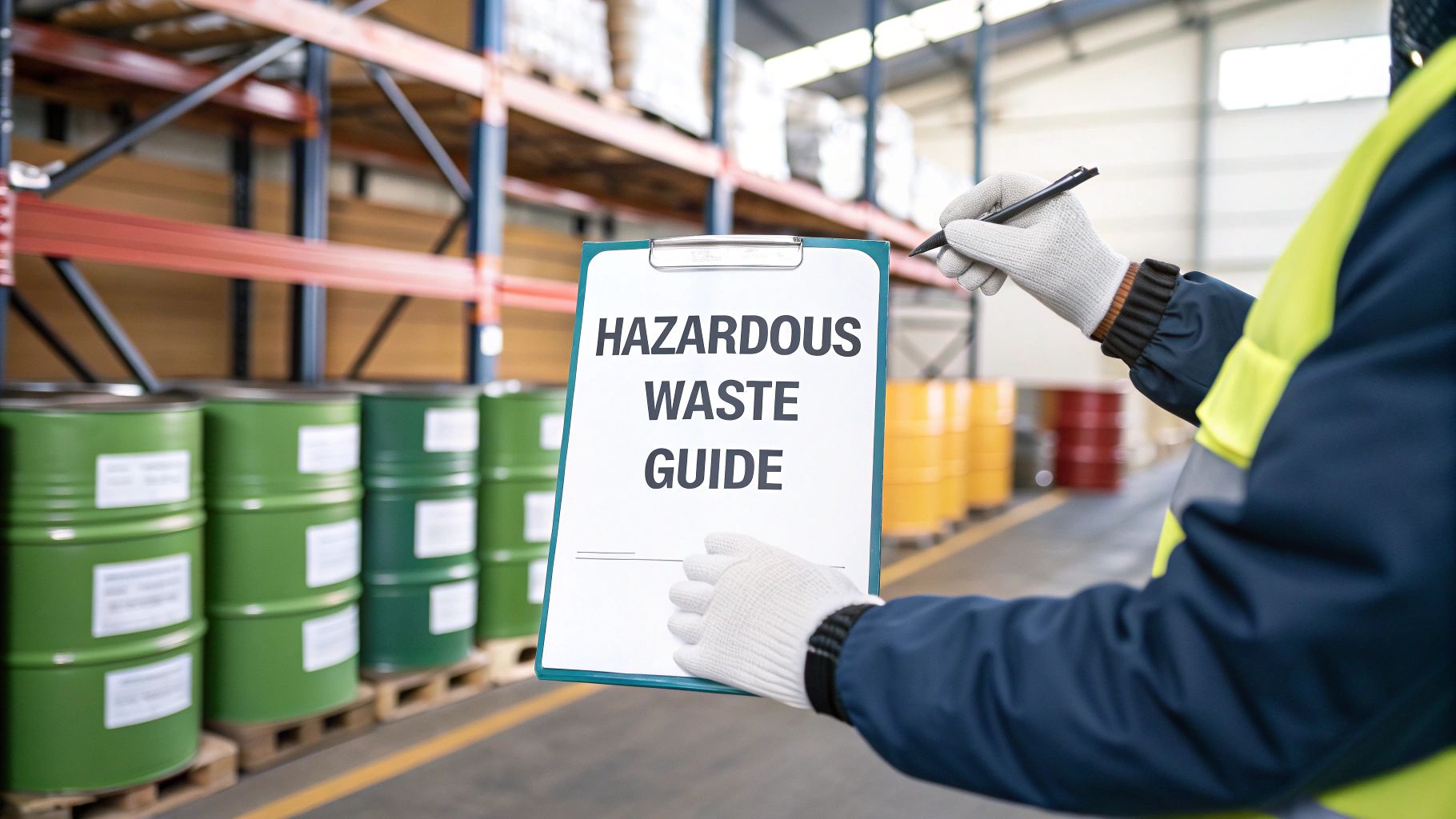A Guide to Waste Disposal in Construction
A Guide to Waste Disposal in Construction..
Properly handling waste on a construction site is about much more than just calling in a skip. It’s a complete strategy that needs careful planning, sorting, and responsible management from the first day on-site until the final handover. Getting this right is fundamental to keeping costs down, staying on the right side of the law, and reducing your project's environmental footprint.
Why Construction Waste Is a Bigger Deal Than You Think

When you look at a building site, that pile of rubble or the overflowing skip is just the tip of the iceberg. What you don't see is a complex challenge with huge financial, legal, and environmental implications. Ignoring what’s lurking beneath the surface can easily sink a project’s budget and tarnish a company's reputation.
Thinking of waste disposal in construction as a simple clean-up job is a costly mistake. It should be seen as a core part of project management, every bit as important as your schedule or procurement plan.
The scale of the problem is staggering. The UK's construction and demolition sector is the country's single biggest producer of waste, generating an estimated 120 million tonnes every year. That accounts for a shocking 62% of all waste produced in the UK. You can dig into the full government statistics on waste generation to grasp the sheer size of it.
The Hidden Costs Below the Surface
When waste management is just an afterthought, the hidden costs start piling up fast. These are the parts of the iceberg waiting underwater, ready to cause serious damage:
- Financial Penalties: Landfill tax for mixed, unsorted waste is eye-wateringly high. Throwing everything into one skip directly eats into your profit margins, turning what should be earnings into an avoidable expense.
- Legal Risks: Every construction business in the UK has a "Duty of Care." This is your legal obligation to ensure waste is handled correctly from the moment it's created to its final disposal. Getting this wrong can lead to unlimited fines.
- Operational Inefficiency: A cluttered, messy site is an unsafe and unproductive one. Time gets wasted moving rubbish around, materials get damaged, and the risk of accidents shoots up.
- Reputational Damage: In today's market, clients and partners want to work with businesses that take their responsibilities seriously. A reputation for sloppy environmental practices can make it much harder to win new contracts and hold onto good people.
By shifting your perspective from waste disposal to waste management, you transform a costly problem into a powerful opportunity. This approach isn't just about ticking boxes; it's about building a more efficient, profitable, and sustainable business from the ground up.
This guide will walk you through the practical steps to get this right. We'll cover everything from identifying different types of waste and understanding your legal duties to putting smart strategies in place that slash costs and boost your green credentials. By the end, you’ll have a clear roadmap for turning your site’s waste into a well-managed asset.
Identifying Your On-Site Waste Streams

Before you even think about booking a skip, the real work of waste disposal in construction begins. It all starts with getting a crystal-clear picture of what you’re actually dealing with on site. Think of it as a pre-emptive audit; you need to anticipate and categorise the waste your project will generate at every single stage, from breaking ground to the final lick of paint.
Trying to manage waste without this foresight is like working blindfolded. It's a surefire way to end up with overflowing mixed-waste skips, spiralling costs, and a mountain of missed recycling opportunities. Get a handle on your specific waste streams, and you can build a sharp, efficient management plan from day one.
Common Construction Waste Materials and Their Sources
To get started, it helps to know what to look for. Different materials crop up at different points in a project's lifecycle. Here’s a quick rundown of what you can expect to find on a typical UK site.
| Waste Type | Common Examples | Typical Project Stage | Key Disposal Note |
|---|---|---|---|
| Inert Waste | Soil, clay, rubble, bricks, concrete | Demolition & Excavation | Heavy and bulky. Often reusable on-site as backfill or aggregate. |
| Wood | Timber offcuts, pallets, plywood, MDF | Structure & Fit-Out | Can be recycled into chipboard or used for biomass fuel. Keep it dry! |
| Plasterboard | Gypsum-based board, drywall offcuts | Fit-Out | Must be segregated. Cannot go to general landfill due to chemical reactions. |
| Metals | Steel beams, rebar, copper pipes, aluminium | Demolition & Fit-Out | Highly recyclable and holds good scrap value if separated cleanly. |
| Plastics | Packaging film, PVC pipes, insulation | Structure & Fit-Out | A complex mix. Hard plastics are more recyclable than soft films. |
| Cardboard & Paper | Delivery boxes, material packaging | Mid to Late Stages | Easily recycled, but quickly becomes contaminated if left out in the rain. |
| Hazardous Waste | Paint tins, solvents, adhesives, asbestos | Demolition & Fit-Out | Requires specialist handling and disposal by a licensed carrier. Never mix. |
By familiarising yourself with these common streams, you're already one step ahead. It’s all about knowing what's coming so you can prepare for it.
Early Project Stages: Demolition and Excavation
The start of any project is where the heavy lifting happens, both literally and figuratively. If you're knocking down an old structure, get ready for a serious amount of concrete, bricks, and metal.
Groundworks and excavation then bring up what we call inert waste. This is your soil, clay, and rubble – stuff that won't decompose or react. It might seem harmless, but even this needs proper handling if you want to reuse it as backfill or aggregate.
Waste from this stage typically includes:
- Concrete and Rubble: Broken slabs, old bricks, and masonry from demolition.
- Soil and Stones: What comes out of the ground when you dig for foundations.
- Structural Metals: Old steel beams, rebar, and other metal framework.
Mid-Project Stages: Structure and Envelope
As the new building begins to rise from the ground, the type of waste changes completely. Now you're dealing with the skeleton and skin of the structure – the frame, roof, and walls. This means a lot of timber, packaging, and offcuts from a whole range of materials.
Material cut-offs and packaging are the biggest culprits here. Every time a sheet of plasterboard is cut to size or a timber joist is trimmed, it leaves a smaller, often useless piece behind. Add to that the plastic wrap and cardboard from every delivery, and it all starts to pile up fast.
A key goal here is to minimise offcuts through careful planning and precise material ordering. Every square metre of material saved is one less square metre that needs to be disposed of, directly impacting your bottom line.
After identifying various on-site materials, understanding the importance of waste segregation becomes paramount for efficient processing and recycling.
Late Project Stages: Finishes and Fit-Out
The home stretch. The final stages generate a high volume of lighter, but much more varied, waste. This is when the interior finishes, electrics, plumbing, and decorating kick-off, creating a seriously complex mix of materials.
You'll see a bit of everything: empty paint tins, plasterboard offcuts, plastic pipe scraps, and huge amounts of packaging from fixtures and appliances. If this mixed bag isn't separated at the source, it becomes the most challenging and expensive stuff to get rid of.
Typical waste from this final push includes:
- Plasterboard (Drywall): Offcuts from fitting all those interior walls.
- Wood: Unused timber, sawdust, and small offcuts from flooring and joinery.
- Plastics: Bits of pipe, electrical conduit, and mountains of packaging film.
- Cardboard and Paper: Packaging from every appliance, light fitting, and tap.
- Hazardous Materials: Things like solvent-based paint tins, adhesives, and sealant tubes need to be handled by specialists.
When you map out these waste streams against your project timeline, you can get the right containers on-site at the right time, schedule collections properly, and make sure your team knows exactly what goes where. This simple act of planning turns waste management from a reactive nightmare into a controlled process that saves you time, money, and a whole lot of hassle.
Navigating Your Legal Duties for Waste Disposal

Let's be honest, legal compliance for waste disposal in construction can feel like a minefield of confusing regulations and endless paperwork. But once you cut through the jargon, it all boils down to a clear set of responsibilities designed to protect your business, your reputation, and the environment.
Getting this right isn't just about dodging fines; it’s a mark of professionalism.
At the very heart of UK waste law is the Duty of Care. The best way to think of it is as an unbroken chain of responsibility. It starts with you—the person creating the waste—and doesn't end until that material is properly recycled or disposed of at a fully licensed facility.
What this means is you are legally accountable for your waste’s entire journey, long after it’s been hauled away from your site. You can't just hire a "man with a van" and wash your hands of it. You have to take all reasonable steps to ensure your waste carrier is legitimate and your materials are heading to the right place.
The Paper Trail That Protects You
To prove you've done your bit, you need a solid paper trail. This isn't just bureaucratic box-ticking; these documents are your legal shield, the hard evidence that you've managed your waste compliantly. For a closer look at managing these kinds of rules, a practical guide to risk compliance management is an excellent starting point.
Two documents are absolutely critical:
- Waste Transfer Notes (WTNs): This is your bread and butter for most non-hazardous waste. Every single load that leaves your site, from rubble to timber, must be covered by a WTN. It details exactly what the waste is, how it’s contained, who collected it, and where it’s going.
- Hazardous Waste Consignment Notes: For the nasty stuff—think asbestos, chemical solvents, or even old paint tins—a standard WTN won't cut it. These materials require a special consignment note and must be handled by a carrier with the specific permits to do so.
You’re required to keep these records for at least two years (three years for consignment notes). They're your first line of defence if the Environment Agency ever comes knocking.
Your legal responsibility for waste doesn't end when the skip is collected. It extends all the way to the final, licensed disposal point. A complete and accurate Waste Transfer Note is your primary evidence that you fulfilled this duty correctly.
Your Best Defence: The Site Waste Management Plan
A Site Waste Management Plan (SWMP) is your strategic blueprint for dealing with every scrap of waste your project will create, from day one to handover. While it's no longer a mandatory legal requirement in England for every project, it's still considered industry best practice—and you'll find most clients and main contractors insist on one.
A good SWMP is invaluable. It helps you:
- Forecast Waste: Predict the types and amounts of waste you'll generate at each project stage.
- Set Targets: Establish clear goals for reducing what you throw away and recycling what you can.
- Define Responsibilities: Make it clear who on your team is in charge of segregation, paperwork, and disposal.
- Track Everything: Create a clear record of all waste movements, linking directly back to your WTNs and consignment notes.
Think of an SWMP as your project's playbook for waste. It pushes you to be proactive, transforming waste management from a reactive headache into a planned, cost-saving process. It provides a crystal-clear audit trail that shows you’re serious about your Duty of Care. This is especially vital for hazardous materials, and our guide on hazardous waste disposal regulations goes into more detail.
Ultimately, a well-kept SWMP is the single most powerful tool you have for ensuring legal compliance, minimising your costs, and building a reputation for being a responsible, professional contractor.
Choosing the Right Waste Disposal Methods
Once you've got a handle on your waste streams and what the law requires, it's time to get practical. Deciding on the right method for waste disposal in construction is about far more than just clearing the site. It's a strategic call that directly hits your project's budget, timeline, and green credentials.
The choice has to work for your specific site, factoring in everything from how much space you have to the sheer volume of material you’re shifting.
Get it wrong, and you're looking at operational headaches—containers that are too small for the job or delivery lorries that can't get down a tight city-centre street. But get it right, and waste management becomes a smooth, almost invisible part of your daily workflow.
Comparing Your Container Options
Not all big metal boxes are the same. The two mainstays on any construction site are the traditional skip and the much larger Roll-on Roll-off (RoRo) container. Each has its place, and knowing the difference is the key to an efficient site.
-
Standard Skip Hire: Absolutely perfect for smaller projects, refurbs, or sites where access is tight. Skips usually come in sizes from 4 to 12 cubic yards. They’re delivered by smaller, more agile vehicles, which makes them a godsend for residential jobs.
-
Roll-on Roll-off (RoRo) Containers: These are the heavyweights. With capacities stretching up to a massive 40 cubic yards, RoRos are built for the big stuff—large-scale demolitions, new builds, and major commercial jobs churning out huge volumes of bulky waste like rubble, soil, and timber.
Think of it this way: a skip is your reliable van for everyday jobs, while a RoRo is the artic lorry you call in for the biggest hauls. Choosing correctly stops you from paying for endless skip exchanges or, just as bad, wasting money on a half-empty RoRo.
The Power of On-Site Segregation
The single most effective thing you can do to slash disposal costs is to sort your waste at the source. It’s the same logic as your recycling bins at home, just on a much bigger, more commercially savvy scale.
Chuck everything into one mixed-waste skip, and you're automatically paying the highest disposal rates and landfill taxes. By setting up dedicated skips or bays for different materials, you turn low-value rubbish into a resource.
Segregating materials like wood, metal, plasterboard, and inert rubble on-site isn't just a nice environmental gesture. It is a powerful commercial strategy that unlocks lower disposal fees and can even generate revenue from scrap metal.
Putting this into practice is surprisingly simple:
- Designate Clear Zones: Set up clearly labelled skips or stockpile areas for specific materials (e.g., "Clean Wood Only," "Metals," "Plasterboard").
- Train Your Team: Make sure every single person on site knows the system and what goes where. This is absolutely vital for creating a culture of smart waste disposal in construction.
- Schedule Smart Collections: Arrange for specialist collections for each separated stream. A dedicated lorry load of clean hardcore or timber costs a fraction to process compared to a mixed one.
This disciplined approach does more than save cash. It makes compliance easier by keeping hazardous materials separate and gives you a crystal-clear audit trail for your Site Waste Management Plan. You can see how this fits into the bigger picture in our complete guide to waste management for construction.
Specialist Disposal Solutions
Sometimes, a standard skip just won't cut it. Certain waste streams need a more specialised touch, and a good waste partner will have solutions ready to go.
Grab Lorry Hire
For sites with mountains of inert waste like soil and rubble, a grab lorry is an incredibly efficient tool. Instead of you labouring to fill a static skip, these vehicles use a hydraulic arm to load waste directly from a pile. They're brilliant for bulk excavations and demolition clearances where speed is everything.
Hazardous Waste Collection
Things like asbestos, old solvent-based paint tins, and chemical containers are a definite no-go for general skips. This stuff requires specialist handling, secure containment, and disposal by a fully licensed carrier. Don't ever take a chance here; the fines for getting it wrong are severe. Always use a certified provider who can give you the proper Hazardous Waste Consignment Note, proving you’ve done your bit.
Implementing Sustainable Waste Management Strategies
Picking the right skips and collection methods is a great start, but truly effective waste disposal in construction is about a much deeper shift in thinking. It’s about moving away from just getting rid of rubbish and starting to see it as a resource waiting to be managed. This is where sustainable strategies, built around the "waste hierarchy," can transform your site from a drain on your budget into a beacon of efficiency.
The hierarchy is a straightforward but powerful idea that ranks waste management options from the best to the worst. By focusing your energy on the top tiers—Reduce, Reuse, and Recycle—you can slash the amount of material that ends up in a skip, saving a packet and seriously boosting your project’s green credentials.
Think of the waste hierarchy as a clear roadmap for smarter material management on any construction project. This infographic breaks down the three core principles that should always guide your strategy.

As you can see, the most powerful actions are the ones you take before waste is even a thing. That’s why reduction is always priority number one.
Reduce The Waste You Create
By far the best way to manage waste is to stop it from being created in the first place. Known as source reduction, this all comes down to meticulous planning and savvy buying. Every offcut you avoid and every pallet you don’t over-order is a direct saving on both materials and disposal fees.
It’s a bit like a chef running a tight kitchen. A good chef plans their menu carefully, ordering precisely what they need to keep food waste to an absolute minimum. A construction manager can, and should, apply the exact same logic.
Here are a few practical ways to put this into practice:
- Precise Material Ordering: Use digital tools or do your takeoffs with surgical precision to calculate the exact amount of materials you’ll need. Ditch the "better get a bit extra just in case" habit that leaves you with piles of surplus plasterboard, timber, and tiles.
- Bulk Deliveries: Have a word with your suppliers. Can they deliver materials in bulk or with less packaging? It’s a simple change that can make a huge dent in the mountain of cardboard and plastic wrap your site generates.
- Prefabricated Components: Using off-site manufacturing for things like roof trusses or wall panels means they arrive on-site perfectly sized, which pretty much eliminates cutting waste on the job.
Reuse Materials On-Site and Beyond
Before you chuck something in a skip, always ask one simple question: can this be used again? Reusing materials is the next best thing to not creating waste at all. It conserves resources, cuts down on transport emissions, and saves you cold, hard cash on buying new.
On any construction site, the opportunities for reuse are everywhere if you just train yourself to spot them. It’s all about seeing potential where other people just see rubbish.
Reusing materials on-site transforms a disposal cost into a project asset. Crushing old concrete for new hardcore, for example, is a classic win-win—you avoid paying to haul it away and you don't have to pay for new aggregate to be delivered.
Some common reuse strategies to get you started:
- Crushing and Screening: Old bricks, concrete, and rubble can be processed right there on-site to create top-notch aggregate for sub-bases, site roads, or backfilling.
- Salvaging Fixtures: On a demolition or refurb job, things like doors, windows, and decent timber beams can often be salvaged. You can either reuse them in the new build or sell them on.
- Reusing Soil: That excavated topsoil? As long as it isn’t contaminated, it’s perfect for the landscaping phase of the same project, saving it from a pointless trip to a landfill.
Recycle What You Cannot Reuse
For anything that can't be reduced or reused, recycling is the final, essential step. And effective recycling boils down to one critical action: on-site segregation. As we've mentioned, separating your materials into dedicated skips is the only way to make sure they can be properly processed at a recycling facility.
This is where teaming up with a certified waste management provider becomes non-negotiable. They’ll supply the right containers and make sure your separated materials—like wood, metal, and plasterboard—actually make it to the correct facilities to be reprocessed. This whole approach is the backbone of a solid construction waste management plan, which spells out exactly how each waste stream will be dealt with.
By putting this three-tiered strategy into action, you’re doing more than just ticking a few best-practice boxes. You’re building a more profitable, efficient, and respectable business that turns the challenge of waste disposal in construction into a real competitive advantage.
The Pay-Off: Why Smart Waste Management is Good for Business
Let's be honest, dealing with waste disposal in construction can feel like just another box to tick. But treating it as an afterthought is a huge missed opportunity. Getting waste management right isn't just about dodging fines; it’s one of the sharpest commercial moves you can make. It can genuinely transform a daily chore into a strategy that makes your company more efficient, more profitable, and far more reputable.
The benefits aren't just vague concepts, either. They hit your bottom line, fast.
The moment you start actively managing your waste streams, you'll see the financial upside. Simply separating materials on-site and following the waste hierarchy can slash your disposal fees. Every skip that doesn't go to landfill is a direct saving on landfill tax, putting money straight back into your project budget.
Boost Your Profits and Your On-Site Efficiency
The savings go well beyond just paying less to get rid of rubbish. A tidy, well-organised site is an efficient site, and that's where smart waste handling really starts to shine.
- Slash Material Costs: Why buy new when you can reuse? Crushing old concrete for hardcore or finding a new purpose for salvaged timber means you're not paying for new materials. Every bit you reuse is a direct cut to your procurement bill.
- Get More Done: A cluttered, messy site slows everyone down. When your team isn't navigating piles of debris, they can focus on the actual job. This means less wasted time, better morale, and a much greater chance of hitting your project deadlines.
- Create a New Revenue Stream: Don't forget, your 'waste' could be someone else's raw material. Cleanly segregated scrap metal, for example, has real value. Instead of paying to have it taken away, you could be selling it.
These aren't just one-off wins. They create a leaner, more effective way of working that helps you deliver projects on time and under budget, again and again.
A proven commitment to sustainability is no longer a "nice-to-have"—it's a significant commercial advantage. Clients, especially in the public sector and large commercial developments, increasingly favour contractors who can demonstrate strong environmental performance.
Sharpen Your Competitive Edge
Beyond the pounds and pence, your reputation is everything. Being able to show a real, demonstrable commitment to sustainable building practices can be the very thing that wins you your next big contract. It proves you're a forward-thinking, responsible company that sees the bigger picture.
A great reputation doesn't just attract better clients; it attracts better talent. The best people in the industry want to work for companies that share their values and are known for their professionalism.
Ultimately, mastering waste disposal in construction isn't just about compliance. It’s about building a stronger, more respected, and more profitable business from the ground up.
Frequently Asked Questions
When it comes to the nitty-gritty of managing waste on a construction site, you’re bound to have questions. Here are some straightforward answers to the queries we hear most often, helping you get it right on your project.
What is a Site Waste Management Plan and is it Still Required?
Think of a Site Waste Management Plan (SWMP) as your project's game plan for waste. It's a document that details what kind of waste you expect to create and exactly how you plan to manage, reuse, or recycle it. It’s your blueprint for dealing with everything from leftover plasterboard to packaging.
Legally, they haven't been mandatory in England since 2013, but don't write them off. SWMPs are now seen as an industry gold standard. Many clients, especially on larger commercial jobs, will insist on one in the contract. It’s the clearest way to show you’re meeting your Duty of Care and running a tight, responsible site.
What is the Best Way to Reduce My Disposal Costs?
The cheapest skip is the one you never have to hire. The real secret to cutting costs is to tackle waste at the source, long before it even becomes a problem. It all comes down to following the waste hierarchy and being smart from the very beginning.
Here are the three most effective ways to slash your disposal bill:
- Get your ordering right. Fine-tuning your material procurement means you only buy what you need, dramatically cutting down on surplus and offcuts.
- Segregate, segregate, segregate. Keep materials like wood, metal, and plasterboard separate on-site. This simple act helps you dodge the hefty landfill taxes that come with mixed waste skips.
- Look for reuse opportunities. Could that crushed concrete and brick be used as hardcore right where you are? Getting creative with reuse is a huge money-saver.
The single biggest financial lever you can pull in waste management is segregation. A skip of clean, sorted hardcore costs significantly less to dispose of than a skip of mixed general waste containing the exact same material.
How Do I Know if My Waste is Hazardous?
Figuring out if your waste is hazardous is a non-negotiable part of your legal Duty of Care. On-site, you’re likely to come across asbestos, solvents, oil-based paints, adhesives, and fluorescent tubes. If you’re ever in doubt about a material, the rule is simple: assume it is hazardous until you can prove it isn’t.
This kind of waste is in a league of its own. It needs specialist handling, separate documentation, and can’t just be tossed in with general rubbish. Instead of a standard Waste Transfer Note (WTN), you are legally required to use a Hazardous Waste Consignment Note. You must also use a carrier who is properly licensed to handle it. Trying to mix hazardous materials into a general waste skip is a shortcut to serious penalties.
For professional and compliant waste disposal in construction, trust the experts. The Waste Group offers a complete range of services, from skip and RoRo hire to specialist asbestos collections, ensuring your project runs smoothly and responsibly. Plan your waste management with us today by visiting https://www.thewastegroup.co.uk.


